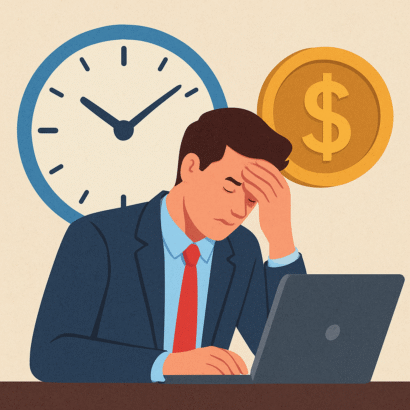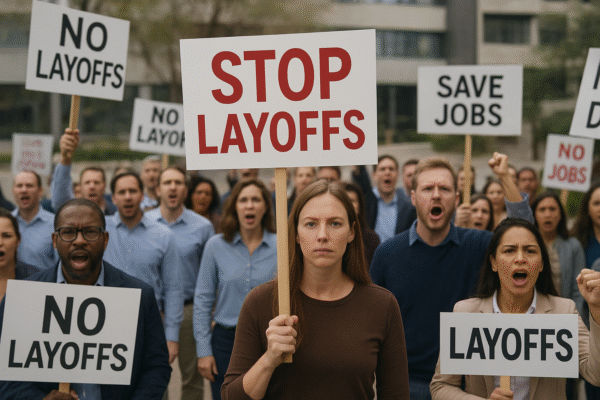Every weekday morning, millions of us step into offices, open laptops, and clock in for their 9 to 5 jobs. On paper, it feels like security—a steady paycheck, health benefits, and a career ladder to climb. But behind the routine lies a reality few talk about.
The truth about 9 to 5 jobs isn’t just about earning money. Studies show that the average full-time employee spends over 90,000 hours at work in their lifetime (World Health Organization). That’s more time than we’ll spend with family, pursuing hobbies, or even taking care of our health. Add in the stress—nearly 60% of workers report being burned out (Gallup)—and the picture becomes clearer: the truth about 9 to 5 jobs isn’t just about earning money, it’s about the silent trade-offs we make every day.
So, the question is: are you truly building a life—or just renting your hours for survival?
⏳ Trading Hours for Money
The math behind the 9 to 5 is brutally simple. You give 40+ hours a week (often more) and, in return, you get a fixed paycheck. But according to Gallup’s 2023 State of the Global Workplace Report, 59% of employees admitted they were “quiet quitting”—essentially disengaged and just working for the money, not the meaning (Gallup Report).
This disengagement isn’t surprising. The average employee spends nearly 90,000 hours at work over a lifetime (World Economic Forum), yet much of that time is dictated by managers, meetings, and rigid schedules. You’re not just working—you’re selling slices of your life that you’ll never get back.
- ⏰ 90,000 hours at work over a lifetime (World Economic Forum).
- 📉 59% disengaged in their jobs (Gallup Report).
❤️ The Cost to Health
The truth about 9 to 5 jobs also extends to physical and mental health. Long commutes, sedentary office work, and constant stress take a toll.
- 🧠 Mentally, the rise of burnout is alarming. In fact, burnout was officially recognized by the World Health Organization in 2019 as an occupational phenomenon.
- ❤️ A study published in the Journal of Epidemiology & Community Health found that people working over 55 hours a week had a 33% higher risk of stroke.
- 🚗 Long commutes + sedentary work = hidden health tax.
If you’ve ever felt drained after work, unable to pursue hobbies, or constantly anxious about Mondays, you’re not alone. It’s a built-in cost of the system.
👉 If you’re stuck in a toxic job, here’s help: Stuck in a 9 to 5 Toxic Job? Here’s How to Break Free.
🎨 The Creativity & Freedom Trade-Off
Another harsh truth about 9 to 5 jobs is how they stifle creativity and limit personal freedom. Work routines are designed for predictability and control—not innovation. That’s why employees often find themselves “thinking outside the box” only after leaving the box entirely.
- ✍️ A Microsoft survey in 2022 found that 70% of workers said their sense of purpose was defined by their work, but only 31% felt their current job allowed them to pursue that purpose (Microsoft Work Trend Index).
💰 The Financial Trap
Many people believe a 9 to 5 guarantees financial security. But the truth about 9 to 5 jobs is that your income is capped, your time is tied, and job stability is no longer guaranteed. Here’s a reality check:
- 🔻 In 2023 alone, over 240,000 tech employees were laid off globally (Crunchbase data). Stability is a myth.
- 📊 Inflation often eats into annual salary hikes, meaning your “real income” may shrink even if your paycheck rises slightly.
- 🚀 Compare this with freelancing, entrepreneurship, or digital product creation—where income can scale independently of hours worked. Freelancing & entrepreneurship = Scalable income.
👉 Avoid regrets: Top 10 Career Mistakes to Avoid (I Wish I Knew Them Early).
⚖️ Work-Life Imbalance: A Silent Exchange
Perhaps the biggest hidden truth about 9 to 5 jobs is what it does to personal life. Family dinners missed, hobbies abandoned, and personal passions delayed for “someday”. Over time, people realize they’ve traded the best years of their life for a paycheck, leaving little room for joy outside work.
- Research from the Harvard Business Review found that 94% of professionals reported working more than 50 hours a week, and nearly half worked more than 65 hours. This means the 40-hour myth is often just that—a myth.
🌍 The Way Out
The truth about 9 to 5 jobs doesn’t mean quitting tomorrow. But it does mean we should question the trade-offs and explore alternatives. Freelancing, remote work, entrepreneurship, and investing are no longer fringe paths—they’re mainstream.
- 🖥️ A 2022 Upwork study revealed that 39% of the U.S. workforce freelanced in some capacity, and that number continues to grow.
- 🌐 Remote work is booming post-pandemic.
👉 Exhausted already? Read: Job Burnout – How To Get Over It Within 30 Days.
🌟 Final Thoughts
The hidden truth about 9 to 5 jobs isn’t that they’re evil. It’s that they come with hidden costs rarely discussed openly—health, freedom, creativity, and sometimes even financial growth.
The good news? In 2025, we have more opportunities than ever to design work around life, instead of life around work. The first step is awareness. The second step is action.
Your paycheck is important—but so is your purpose, health, and freedom. Don’t let the illusion of fame, money, stability blind you to what you’re really trading.





Leave a Reply